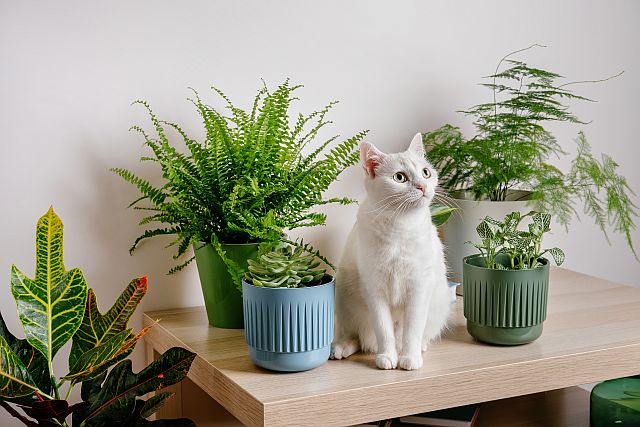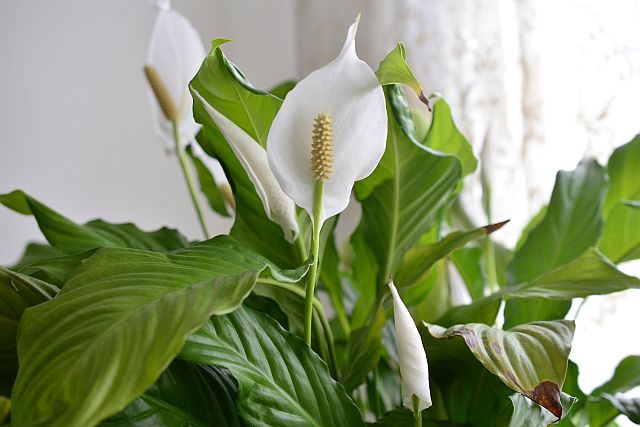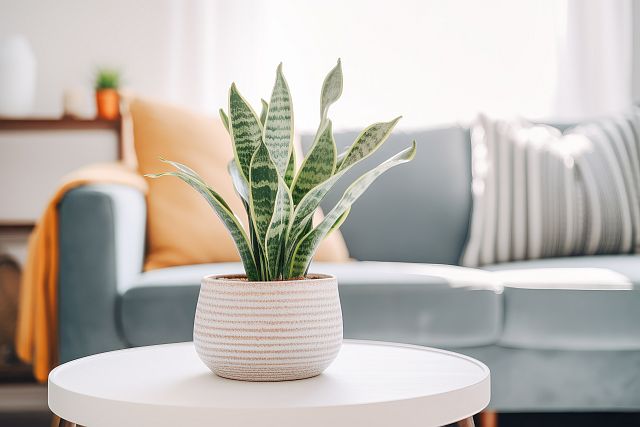How do indoor plants purify air and help to remove toxins? We set out to find out, and learn more about air-purifying plants in general. As an added bonus, these plants can be used to personalise your rental too and create an individual environment that reflects your personality, style, and tastes.
How Do Plants Clean the Air and Provide Cleaner Air?
All plants absorb carbon dioxide and release fresh oxygen during photosynthesis. This is one of the first things we learn in Botany 101. They also take in oxygen and release carbon dioxide during respiration.
What’s perhaps less well known though is that they also absorb toxic chemicals! Although this sounds dangerous – for the plants – they are, fortunately, far better equipped to deal with these harmful toxins than we are!

De-toxing the Environment Naturally
Along with carbon dioxide and oxygen, many plants absorb air-borne contaminants through pores in their leaves. They also take up contaminants in the soil through their roots. The contaminants are then metabolically broken down either internally, or by enzymes released from the roots prior to absorption.
The various processes they use to do this – phytodegradation, phytostabilisation, phytovolatilisation, phytoextraction, phytotransformation etc – are part of a broader process called ‘phytoremediation’.
Phytoremediation
Phytoremediation per se is the removal of contaminants from water, soil, and air – by plants. It is now widely used to clean up contaminated environments e.g. old mines, waste discharge sites and, increasingly, indoor air pollution as well.
Some plants are better at absorbing and breaking down certain types of pollutants whilst others are hyperaccumulators and can absorb and store toxins at levels that would kill most other plants! Lavender for instance can accumulate very high amounts of Lead and high amounts of Zinc and Cadmium.
Interesting sidenote – ‘plant mining’ is a process used to recover waste metals (copper, lead, zinc etc) from old tailings areas and mine sites. It involves planting hyperaccumulating plants for a target metal or metals over the designated area so they absorb and accumulate the metal or metals.
The plants are subsequently harvested and processed to recover the metal/s thereby achieving 2 things – decontamination and recovery of a viable commodity. However, it is a slow process and often involves several rounds of planting over a period of years.
What Pollutants do Plants Remove From Your Home?
Plants are proven to remove several well-known contaminants that are found in a range of products we use in our homes. Knowing more about these pollutants will help you choose the most effective air purification plants for your home.
Formaldehyde
Formaldehyde is a preserving agent with strong anti-bacterial, anti-fungal, and anti-microbial properties. It is commonly used in liquid form to store animal and plant tissues in laboratory situations. However, you’ll also find formaldehyde utilised as a preservative in pressed timber products – plywood, particleboard etc – used to make furniture, in household cleaning products, and even in personal care products.
Formaldehyde releases a colourless gas that is easily recognised by its strong, pungent smell. Ongoing exposure to formaldehyde gas can cause skin irritation and respiratory issues.
There are a few plants, like the
Bamboo palm (Chamaedorea seifrizii),
Janet Craig Dracaena,
Boston fern (Nephrolepis exaltata ‘Bostoniensis’),
Chrysanthemum morifolium; and
Dwarf date palm (Phoenix roebelenii),
which can very effectively take out formaldehyde in enclosed spaces like your home.
Benzene
Benzene is used in synthetic fibres, rubber, resins, plastics, Styrofoam and so on to improve their durability and flexibility. However, the biggest sources of benzene in the environment by far are petrol and oil.
Within your home you may also find it in glues, detergents, paint strippers, solvents, pharmaceuticals, dyes, and, if one of you is a smoker, in tobacco smoke! At room temperature, Benzene is a light yellow or colourless liquid with a distinctive sweet smell. It evaporates quickly and if inhaled in sufficient quantities causes a range of blood tissue disorders including leukaemia.
Effective Benzene filterers include the
Barberton Daisy (Gerbera jamesonii),
Chrysanthemum morifolium; and
Peace lily (Spathiphyllum ‘Mauna Loa’) – pictured below:

Xylene and Toluene
Xylene and Toluene are solvents and both present as a colourless liquid with a sweet smell. They are one of the BTEX chemicals (Benzene, Toluene, Ethylbenzene, Xylene) and are used in varnishes, paints, and adhesives to improve their consistency and application properties.
Even minimal exposure to vapours from these compounds can cause dizziness, nausea, headaches, and drowsiness. They also cause mild skin, eye, and lung irritation. Long term or chronic exposure has further serious effects, including death in extreme circumstances.
If these two toxins are a problem in your home, palms like the Areca or butterfly palm should top your list of air purifying plants. Other plants also proven to remove these two toxins include:
Peace lily (Spathiphyllum ‘Mauna Loa’)
Florist’s chrysanthemum (Chrysanthemum morifolium)
Parlour Palm (Chamaedorea elegans)
Lady Palm (Rhapis excelsa)
Bamboo palm (Chamaedorea seifrizii)
Variegated snake plant, mother-in-law’s tongue (Sansevieria trifasciata ‘Laurentii’)
Janet Craig (Dracaena fragrans “Janet Craig/Cornstalk Plant”)
Warneckei (Dracaena deremensis “Warneckei”)
Red-edged dracaena (Dracaena marginata)
Cornstalk dracaena (Dracaena fragrans ‘Massangeana’)
English ivy (Hedera helix)
Devil’s ivy, Pothos plant (Epipremnum aureum)
BostonFern (Nephrolepis exaltata ‘Bostoniensis’)
Spider plant (Chlorophytum comosum)
Chinese evergreen (Aglaonema modestum)
Weeping fig (Ficus benjamina); and
Dwarf date palm (Phoenix roebelenii)
Trichloroethylene
Trichloroethylene is an industrial solvent and like the above, is a colourless, sweet smelling liquid. It is used in degreasers but is also found in paints and varnishes. Long-term exposure can cause dizziness, headaches, and also liver damage.
Topping the list of best air purifying plants to remove this toxin are the
Barberton Daisy (Gerbera jamesonii),
Red-edged dracaena (Dracaena marginata); and
Peace lily (Spathiphyllum ‘Mauna Loa’).
Ammonia
The chemical ammonia is probably the chemical we’re most familiar with in household products. Ammonia liquid produces a colourless but very strong, distinctive smell. It is a strong disinfectant, stain remover, and degreaser so is used in cleaners and degreasers, and in some industrial processes. It’s also used in fertilisers. High concentrations of ammonia gas in the environment can irritate your eyes, nose, mouth, and throat.
Adept ammonia filtering plants include
Chrysanthemum morifolium,
Peace Lily (Spathiphyllum ‘Mauna Loa’),
Parlour Palm (Chamaedorea elegans); and
Lady Palm (Rhapis excelsa).
Tips to Personalise Your Rental Home With Air-Purifying Indoor Plants
Once you’ve decided which types of air-cleansing plants best suit your home, you can get stuck into creating a healthier, and personalised, indoor environment for you and your family. Here are some ideas to help you get started:
1. Place plants where they’ll get the right amount of light and sunshine to grow and look their best.
2. Maintain them properly to get the best results visually and from an air-cleaning aspect. Dead and dying plants aren’t going to purify much air!
3. Maximise your space and mix up the layers and heights with plant stands, shelves, and hanging pots.
4. Create visual interest and impact with different colours, foliages, shapes, and sizes. Consider under planting taller plants like palms with small colourful contrast plants to make things interesting.
5. Use pots and stands that suit your décor and achieve the effect you want. They come in a huge range of shapes, sizes, materials, and colours.
6. Create mini indoor gardens by grouping plants together for maximum impact and interest.
7. Use trailing plants in hanging baskets – Devil’s Ivy and ribbon plants are not only great indoor air purifiers but also make extremely attractive hanging feature plants.
8. Incorporate trailing plants: Hanging or trailing plants like pothos or spider plants can add dimension and depth to your decor, especially if you have limited floor or surface space.
Final Thoughts on Plants and How They Can Transform Indoor Air Quality
Plants – indoor and outdoor – are not only beautiful, living works of art but have a remarkable ability to improve our environment and air quality that goes beyond the well-known conversion of carbon dioxide into oxygen. Integrating plants proven to improve fresh air into an indoor space, like your rental home, creates both a restful environment and a healthier one by removing some of the most common, and harmful, air-borne contaminants.

